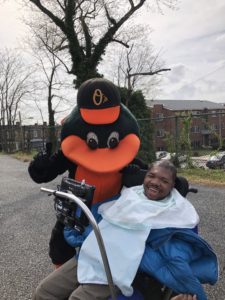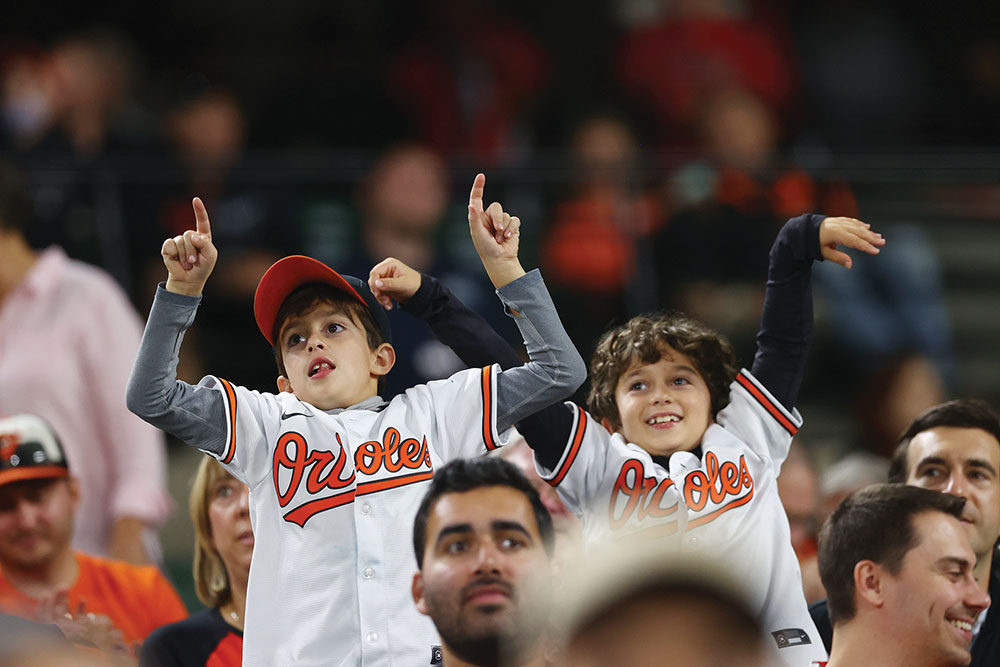Years ago, on a spring morning in East Baltimore, 2-year-old Carlos Woods opened his front door, looking for his juice bottle. At the same moment, Kenneth A. Kelley rounded the corner onto Carlos’ street, looking for vengeance.
Kelley, armed and bent on murdering a rival, shot four bullets at his intended target just as Carlos stepped outside. One of them split the back of Carlos’ skull.
Sirens and screams punctuated Carlos’ departure for Johns Hopkins Children’s Center, where neurosurgeons (including Benjamin Carson) operated for hours.
Against the odds, Carlos survived.
According to The Baltimore Sun, Kelley pleaded guilty to attempted second-degree murder and was sentenced to 11 years in prison, serving seven years of his sentence before moving back into Carlos’ neighborhood.
Meanwhile, Carlos kept surviving, recovering for nearly a year in the hospital, according to his great-grandmother Rosetta Marks. His family and even his doctors “really didn’t know what was going to happen,” she says.
Today, Carlos is 20 years old and about to start his final year at the William S. Baer School, a city public school for children with severe and multiple disabilities. He also receives extensive medical care and therapies through Kennedy Krieger Institute, according to Marks.
 The bullet appears to have cost Carlos nearly all his motor skills, says his Baer School occupational therapist Nancy Doran, who has worked with Carlos for most of his life. “He has severe physical impairment,” she says. “He has very limited movement. He’s mostly in a wheelchair, but we do put him in a very supportive standing device. He has trouble swallowing and takes most of his nutrition by tube.
The bullet appears to have cost Carlos nearly all his motor skills, says his Baer School occupational therapist Nancy Doran, who has worked with Carlos for most of his life. “He has severe physical impairment,” she says. “He has very limited movement. He’s mostly in a wheelchair, but we do put him in a very supportive standing device. He has trouble swallowing and takes most of his nutrition by tube.
He can take some pureed food by mouth, but it’s not easy for him.”
Though Carlos’ story illustrates the most gut-wrenching face of gun violence in Baltimore, his educators, therapists and family assert Carlos’ life, while changed irrevocably, is no tragedy.
“People say, ‘What if’ about Carlos,” says retired Baer School principal Patrick Crouse, who has known Carlos for more than a decade. “He’s not a ‘what if.’ He’s a ‘meant to be.’ He’s amazing.”
Carlos has lived off and on with his great-grandparents, Robert and Rosetta Marks, in their East Baltimore rowhome since he was about 3 or 4, Marks says. Carlos was born when his mother was 13, and Carlos’ father has been incarcerated nearly the entirety of Carlos’ life. With a mother who was “too young” to handle Carlos’ complex medical needs, says Marks, his extended family stepped up.
“Everybody pitched in,” she says. Her grandson, for example, helps to carry Carlos up and down the three marble steps to the rowhouse door as well as bathe him.
“Everyone has something to do, and everybody starts chipping in,” she says. “As the grandchildren got older, they watch him, take him outside. He thinks he’s the boss of all the little ones. They just have a ball, all of them.”
Carlos is “happy all the time,” Marks says. She believes it’s because he knows “he’s well loved.” The real surprise, she says, is his sense of humor. Although he’s nonverbal, he communicates clearly in other ways.
“He voices his opinion. We all can understand him, certain words and everything,” she says. “He would be having them laughing at Kennedy Krieger. They don’t know what trick he’s going to play on them, what he’s going to do. He makes a joke out of everything.”
He can also communicate his musical tastes. “He loves Beyonce,” Marks says. “He can hardly talk, but he can sing all the songs with her.”
Faye Menis, a teacher at the Baer School who has worked with Carlos for three years, is amazed at “how responsive he is, how social, how he’s able to use his device.”
His device is called an augmentative communication device, which is essentially a computer he can control with his eyes to communicate. An infrared beam tracks Carlos’ eye movements, and when the retina focuses on an image or word, the computer says the word aloud.
“The control he has with his eyes and how he’s learned to control that over time is impressive,” says Menis, who has tried to use the device herself. “I’ve tried to do it. It takes so much, and by the end my eyes are just burning. You’re trying to focus all the energy on one body part.”
This year, teachers and therapists have worked with Carlos to use his device to connect multiple words to assist with language development.
Carlos has a developmental delay, but Menis says “there are so many holes” in the available testing systems that he’s probably functioning at a level higher than test scores might indicate. His grandmother also sees intelligence behind the curtain of paralysis. “He’s very observant,” Marks says. “He keys in on everything. When everybody gets together like for a birthday, he’s right there. He knows whose birthday it is.”
Several years ago, Carlos’ friend from school died and Carlos “was so upset,” Marks says. “That’s when I knew he could recognize when someone’s not here.” Doran voices the same opinion. “Intellectually,” she says, “he’s very aware of everything.”
Menis says Carlos is funny, caring, persistent and very competitive, but “there’s a lot of teenage stuff going on, too.” For instance, he has a flirtation going on with a classmate, and he can get distracted.
“If he’s in that distracted mode,” Menis says, she’ll try to incorporate humor into the lesson to show him “there’s a way to be funny, but you still have to do the work.”
Carlos’ academic work is interspersed with care for his medical needs — it takes two hours to tube-feed lunch — and work with his therapists.
“I don’t see that the disability has held him back,” Menis says. “He has found a way to prosper and thrive as any student should, given the opportunity. A lot of that has to do with him and his unique ability to look beyond or not even recognize the things that have happened to him as barriers. His whole world has changed, but he’s been able to continue to grow.”
Doran agrees that Carlos optimistic and upbeat. “For some reason, even though he should be mad about [his situation], he’s really happy every single day,” she says. “He laughs all the time, he’s happy to be here, he’s happy to see people all the time. Throughout it all, he smiles and laughs. It’s remarkable.”
Doran says he always asks to do his occupational therapy at the school store. “One of his favorite things that I do with him for occupational therapy is take him into the [school] store and have him greet customers, which he loves to do.”
On days when the weather is nice, Carlos is already an unofficial greeter outside his grandmother’s home on Rutland Avenue, one block away from Chapel Street, where he was shot. He loves to sit outside and talk to people, his grandmother says. He makes people happy by being there, and his street is so much the better for his presence in another less expected way.
“The drug [trade] is always around here,” Marks says. “But not in this block. Not anymore. Because Carlos is here.”








